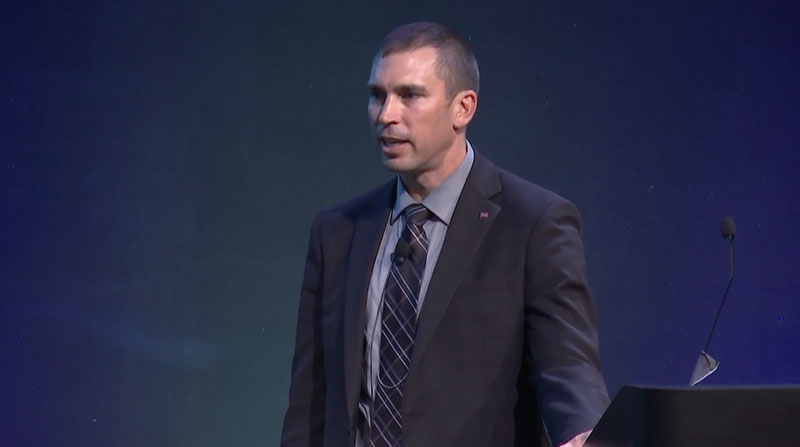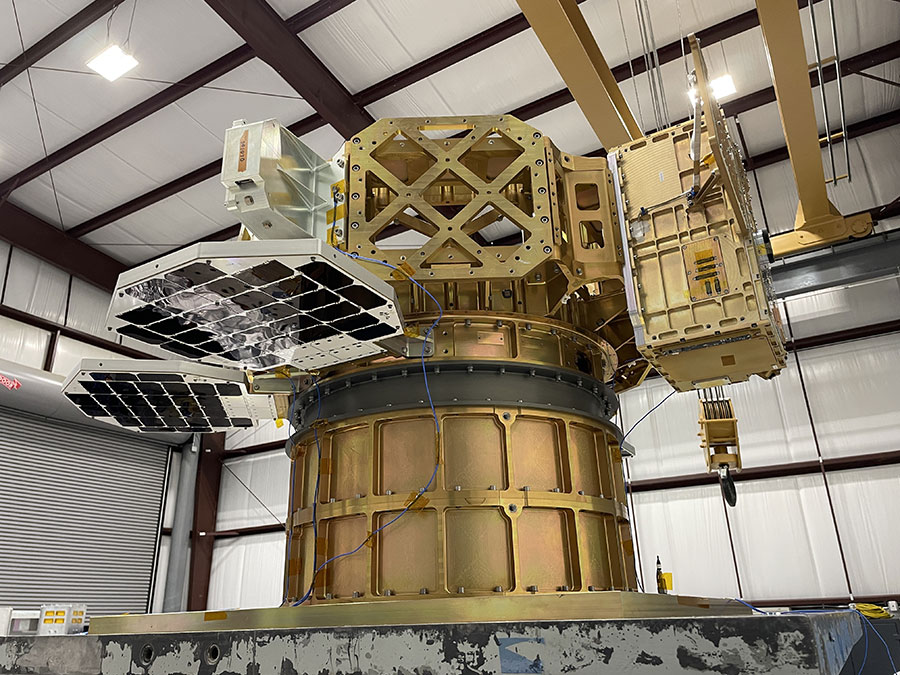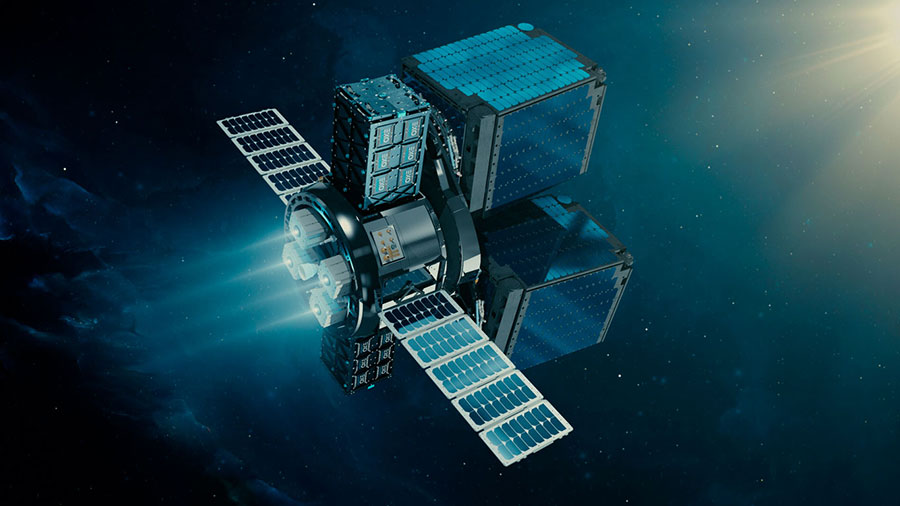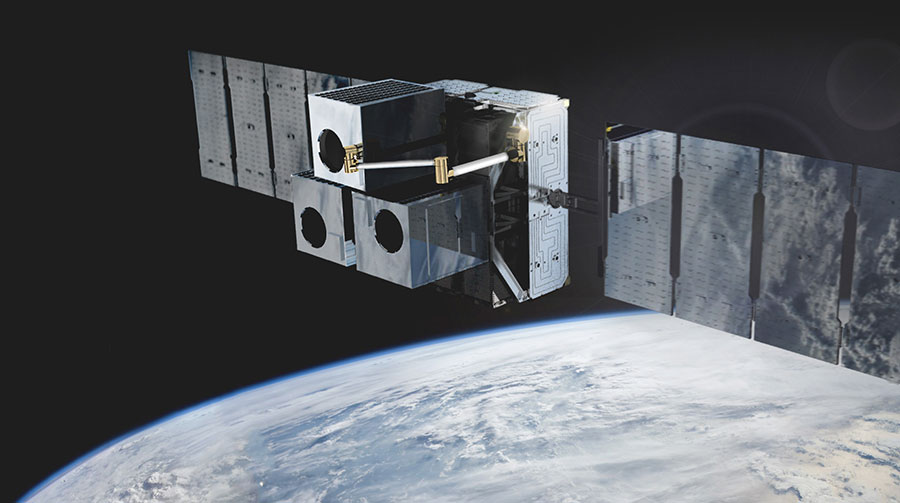 Director of the Space Development Agency Derek Tournear delivered a keynote address, Oct. 13, 2022 at the MilSat Symposium in Mountainview, Calif. (Source: Milsat Symposium 2022)
Director of the Space Development Agency Derek Tournear delivered a keynote address, Oct. 13, 2022 at the MilSat Symposium in Mountainview, Calif. (Source: Milsat Symposium 2022)
ALEXANDRIA, Va. — In-space service providers contacted by Constellations responded to the recent comments from the head U.S. Department of Defense’s rapid space acquisition agency who signaled interest in “space tug” solutions to deorbit satellites.
Speaking at the 2022 MilSat Symposium earlier this month, Space Development Agency (SDA) Director Derek Tournear said the agency was seeking an affordable solution to deal with spacecraft that have reached end of life.
“I am very interested and would encourage folks to develop that technology for the space tug, deorbit-as-a-service kind of technology, because that enables the satellites’ costs themselves to go down,” Tournear said.
He explained how the service could open opportunities for satellite operators to develop experimental propulsion systems and reduce the time and cost of building and testing redundancy in onboard propulsion “without the fear that if they fail, I’m stuck up there for a thousand years.”
The comments came in response to a question about SDA’s planned compliance with the recent U.S. FCC ruling requiring satellites in low-Earth orbit to deorbit within five years of completing their mission. SDA plans to deploy a mesh network of 300-500 optically interlinked satellites in two-year increments to form the communications backbone of the U.S. Department of Defense’s Joint All-Domain Command and Control (JADC2) architecture.
“If there are affordable tugs that can deorbit those satellites, that’s certainly a service I encourage,” Tournear said.
Orbital Services Here and Now
Several companies that have deployed or are developing orbital transport vehicles (OTVs) or orbital service vehicles explained that the capabilities Tournear described exist today.
“Affordable OTVs are already available,” said Curt Blake, CEO of Spaceflight, a launch and orbital service provider based in Washington State.
Spaceflight has successfully launched five Sherpa OTVs in the past two years, helping operators “reduce costs and risk,” while providing flexibility to reach multiple orbits. The company’s Sherpa LTE, with a high specific impulse (ISP), low-thrust propulsion system, is capable of delivering spacecraft to GEO, Cislunar or Earth-escape orbits.
 Spaceflight’s Sherpa LTC is the fourth iteration of the company’s orbital transfer vehicle. Sherpa LTC features a bi-propellant, green propulsion subsystem utilizing Benchmark Space Systems’ Polaris propulsion technology for low-cost, rapid orbital transfer for small spacecraft. (Source: Spaceflight)
Spaceflight’s Sherpa LTC is the fourth iteration of the company’s orbital transfer vehicle. Sherpa LTC features a bi-propellant, green propulsion subsystem utilizing Benchmark Space Systems’ Polaris propulsion technology for low-cost, rapid orbital transfer for small spacecraft. (Source: Spaceflight)
John Rood, CEO of Momentus Space, an in-space transportation service company based in California, said his company is “not far off” from an economical deorbit service. Given the SDA’s 2-year development increments, Rood estimates Momentus is “contemporaneous with the need-date these [SDA] constellations would require.”
In May, Momentus deployed a demonstration mission of its Vigoride OTV and it has three more missions scheduled for 2023. The company plans to have a reusable service vehicle by mid-decade with a robotic arm for deorbit and in-space servicing.
Kier Fortier, U.S. Managing Director of the German launch service provider Exolaunch, emphasized the importance of elevating the issue of deorbiting services. He noted that Exolaunch is seeing growing demand for its Reliant OTV to “provide reliable and affordable last-mile delivery services.” Reliant, which is currently under development, will be capable of debris removal and responsible deorbit at the end of its mission.
 Illustration depicts Exolaunch’s Reliant orbital transfer vehicle. The Reliant space tug is powered by an innovative green propulsion system and provides a high thrust-to-weight ratio. (Source: Exolaunch)
Illustration depicts Exolaunch’s Reliant orbital transfer vehicle. The Reliant space tug is powered by an innovative green propulsion system and provides a high thrust-to-weight ratio. (Source: Exolaunch)
SpaceLogistics, Astroscale, Redwire Space and others are among the commercial players advancing OTVs and other on-orbit services, such as debris removal, orbital placement, satellite life extension and manufacturing.
Economics Favor OTVs
Tournear acknowledged that he was not always a “believer” in on-orbit services as a business model because he didn’t see the cost advantage in deploying a service spacecraft over using onboard propulsion.
That calculus begins to change when considering the lower engineering costs for onboard propulsion systems, ensured compliance with the FCC’s 5-year rule and the benefits of new orbital service capabilities. “It starts to become a wash if you get affordable tug services,” Tournear said.
Blake noted that OTVs capable of carrying multiple satellites at once would increase the efficiency of last-mile delivery for deorbit and launch. Orbital service vehicles “decrease the need for individual spacecraft to have their own propulsion, making the cost and risk of getting to that final destination more economical than buying a dedicated launch.”
There are also cost savings in allowing operators to safely fly their satellites beyond their estimated lifespans, without being marooned in orbit. For example, each satellite in the SDA’s Tranche 1 Transport Layer (T1TL)—scheduled to begin launch in 2025—cost roughly $14 million. Of the 126 LEO satellites in T1TL, a small number are likely to be dead on arrival. Others will fail before their estimated lifespan (roughly five years). Still others will exceed their estimated usable life by as much as 50%-100%.
“My experience with satellite operators, whether they’re in government or commercial, is they’re loathe to deorbit a functioning satellite,” Rood said. This is particularly true in LEO, where deorbit maneuvers can take up to six months, or 10% of the satellite’s usable life.
 An illustration of Momentus’ Vigoride orbital transfer vehicle featuring microwave electrothermal thrusters to provide low-cost, efficient, safe propulsion. (Source: Momentus Space)
An illustration of Momentus’ Vigoride orbital transfer vehicle featuring microwave electrothermal thrusters to provide low-cost, efficient, safe propulsion. (Source: Momentus Space)
But operators that push the lifespan of their spacecraft also increase the risk of creating space debris that directly impacts constellation management.
“They [spacecraft] don’t always fail in areas that are graceful for the overall constellation,” Rood continued. Failure can often occur in a node where the operator needs communications or observational capability. “Having an orbital service vehicle, you get them out of the way so you’re not using up a fair amount of fuel and management time trying to avoid debris.”
Future Demand for In-Space Services
In April, the U.S. government released an ISAM strategy, announcing the need to invest in and coordinate with commercial entities developing ISAM capabilities. The United Kingdom announced a £5 million investment in Active Debris Removal, de-orbiting defunct satellites and in-orbit servicing and manufacturing missions as part of its Plan for Space Sustainability. Japan contracted with Astroscale on several deorbiting services to remove space debris. The European Union, China and a few other space leaders are also making strides in on-orbit services.
Spacefaring nations are signaling more interest in OTVs as part of a larger Orbital or In-Space Services, Assembly and Manufacturing (OSAM or ISAM) strategy to improve the sustainable use of space through orbital management, debris removal, on-orbit repair, refueling and life extension.
The overall market for “space tugs” and ISAM has yet to demonstrate the maturity of other parts of the space economy. While the demand signal from the SDA director appears promising, there are lingering challenges for the emerging industry. Launch costs continue to decline and less expensive, short-lived satellites make replacement an attractive option for many operators. Industry players are also recognizing the need to discuss standards—such as interfaces for refueling, docking and grappling.
The growing sense of urgency among spacefaring nations over orbital debris and congestion may push ISAM developments further faster. According to NASA, 60% of the roughly 11,400 satellites that have been placed in orbit are still there and only 35% are still operational. The ESA is tracking over 30,000 pieces of space debris and has documented a growing number of close encounters between LEO satellites and stray objects.
The extent to which governments and commercial operators will prioritize ISAM investment remains to be seen, but issues of orbital sustainability, affordability, congestion and national security imperatives remain top of mind.
Explore More:
Affordability Is Transforming the Satellite Industry
Podcast: Building in Sustainability, Cislunar Infrastructure and Furthering Exploration
Podcast: Space Debris, Climate Change and Euthanasia for Satellites
